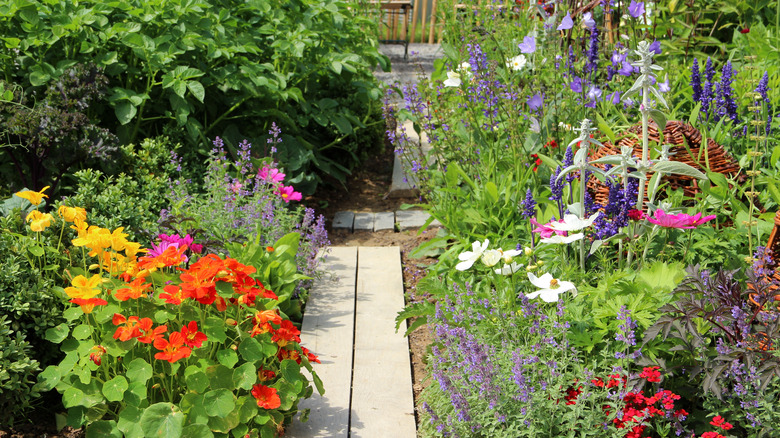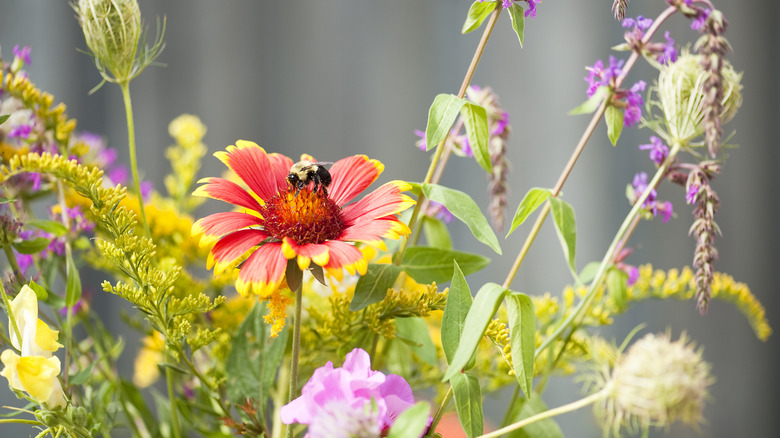TikTok's Wildflower Garden Has Viewers Divided. Here's Why
Sick of having to keep up with your well-manicured lawn? If you're looking a solution that is lower maintenance — and is actually beneficial for the environment — maybe it's time to consider digging up the lawn and planting a field of wildflowers instead.
As the latest TikTok gardening craze, it seems that many gardeners are either partially or completely ditching their lawns and replacing their green space with wildflower gardens. Now, sure, these gardens certainly look picturesque. But after taking a closer look at the comments on these videos, many TikTok viewers bring up quite a few valid arguments to consider before choosing which colorful wildflowers to grow in your garden. Let's take a look at both sides of the argument and dive into both the pros and the cons when it comes to tending a wildflower garden. Besides having fresh, beautiful bouquets of wildflowers at your disposal, here's everything else to consider if you're thinking of swapping your lawn with a natural wildflower habitat.
The pros of having a wildflower garden
Compared to other flower and plant gardens, wildflowers are easy to set up and maintain — especially if your lawn gets a good amount of sunshine on the daily. If you're planting in the spring, all you have to do is toss a wildflower seed mix with sand, then spread evenly over your prepared soil (free of grass and weeds) after the last frost, then compress the soil and seed using cardboard or plywood before watering. Wildflower seeds don't even need to be covered — they just need consistent water for four to six weeks, until the seedlings are six to eight inches tall. At this point, the flowers can absorb the groundwater and live naturally without constant maintenance. Plus, wildflowers can out-compete weeds, not giving them the space to grow compared to a grass mix. When you remove grass, there is less weed pressure and fewer weed seeds in the soil.
Significantly, wildflower gardens also foster a healthy natural habitat, compared to the burden of tending to a grass lawn that is harmful to the ecosystem and requires a lot of watering. Wildflowers thrive on their own — with the occasional watering, depending on the climate — and also attract natural pollinators that help your local ecosystem thrive, such as bees, butterflies, and birds. Flowers also attract beneficial insects such as lady beetles, green lacewings, and various flies and wasps who help to keep predatory insect populations away from your home landscape.
The cons of having a wildflower garden
On the flip side, while a wildflower garden attracts pollinators like butterflies and bees, that also means having to regularly walk through a field of wildflowers buzzing with ... well, bees. Having a teeming field of tall flowers with bugs certainly gives some TikTok viewers the heebie-jeebies. However, bugs aren't the only wildlife attracted to these flowers. Deer and rabbits tend to be the most common guests, hence why many wildflower gardens you are grown in fenced areas. Snakes also thrive in gardens with plenty of spots to hide and hunt for other critters like rodents, small amphibians, large bugs like spiders, and some birds.
Speaking of seed mixes, the last con to consider is what's actually in the seed mixes you buy. Some seed mixes may contain invasive species that are not native to the area you live in, which can alter the ecosystem of plants and animals attracted to your flowers. It may be tempting, but you should avoid buying a cheap seed mix at a big box store. A high-quality mix is likely curated for your environment and will thrive in the long run.

